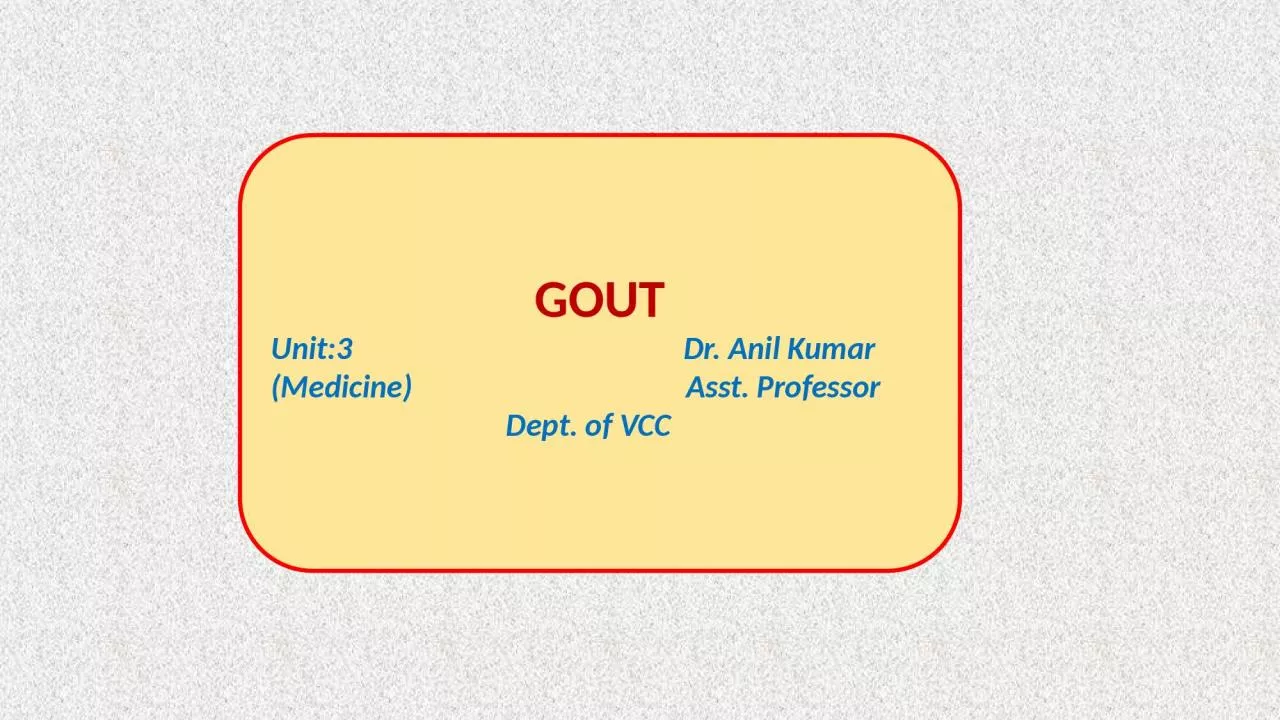/


Dr Anil Kumar Medicine Asst Professor Dept of VCC GOUT Introduction The term gout in general term refers to a form of inflammatory arthritis ID: 914801
Download Presentation The PPT/PDF document "GOUT Unit:3" is the property of its rightful owner. Permission is granted to download and print the materials on this web site for personal, non-commercial use only, and to display it on your personal computer provided you do not modify the materials and that you retain all copyright notices contained in the materials. By downloading content from our website, you accept the terms of this agreement.
Slide1
GOUT
Unit:3
Dr.
Anil Kumar
(Medicine) Asst. Professor
Dept. of VCC
Slide2GOUT
Introduction:
The term
“gout”
in general term refers to a form of inflammatory arthritis.
Gout is defined as abnormal accumulation of uric acid in the bloodstream and consequent deposition of uric acid on and within visceral tissues and articular surfaces.
Gout is an inherited disorder of purine metabolism that causes
hyperuricemia
.
Gout is rare in most other animals due to their ability to produce
uricase
, which breaks down uric acid
Uric acid is the end product of nitrogen metabolism in birds, and it is produced in the liver.
Host:
Birds
Etiology
:
Renal disease
Increased protein ingestion
Prolonged dehydration
Reduced renal excretion of urates.
All these will lead to formation Monosodium
urate
crystal precipitation in tissues
Slide3Slide4Classification
: I. visceral or
II. articular III. BothAll species, regardless of age and sex, are susceptible.Some birds like Budgerigars are predisposed to articular gout.Clinical Findings:Uric acid deposits within synovial capsules and tendon sheaths of joints (the metatarsal and phalangeal joints).Uric acid deposits on and within the tissue of major organs.Diagnosis:Physical ExamWhite raised nodules on the feet and lower legsPolyuria and polydipsia (Parrots)Nonspecific (depression, anorexia, and depression)
Slide5Haemato
-biochemical Findings:
Complete blood count (CBC):
I. Nonregenerative anaemia due to decreased secretion of erythropoietin OR prolonged cases of renal disease.Elevation in uric acid Inverse calcium-to-phosphorus ratioRadiographic imaging: Radiopaque opacities on articular and visceral surfacesCytologic smears with gram’s staining- made from raised white nodules on the feet reveal uric acid crystalsUSG: coelomic air sac system hamper the USG, but the hyperechoic areas within the kidneys may be indicative of uric acid crystal deposits in renal tissue.
Gross necropsy/
histopathologic
examination:
visceral gout is
characterized by
precipitation of
urate
crystals in
the kidneys
or on the
serosal
surfaces
of heart
, liver, mesenteries, air sacs,
and/ or
peritoneum.
Slide6Articular gout
is
characterized by
deposits of urate crystals (also known as tophi) on both intraarticular and periarticular tissues.Urate deposits appears as chalky, white covering in both articular and visceral gout.Histologically, Uric acid crystals are found within the lamina propria of the proventriculus, ventriculus, intestines, and kidney.Treatment: The main goal is to: To reduce painTo reduce the incidence of tissue
and articular
deposition of uric acid
crystals
Supportive
care
Acute Cases:
Hyperuricemia
is treated with
aggressive diuresis
with intravenous or
intrasosseous
fluid therapy
Decrease
protein
ingestion
Prolonged
SC fluid
administration is often recommended
Slide7Slide8Chronic
Cases:
Response
to treatment is poor to non-existent.Allopurinol 10 mg/kg PO q 4-12 hourColchicine 0.04 mg/kg PO q 12-24 hourVitamin A 33,000 IU/kg (10,000 IU/300 g) IM q 7 days.Omega-3 fatty acid (0.1-0.2 mL/kg of flaxseed oil to corn oil mixed at a ratio of 1:4 PO ) or added to food; ratio of omega-6/omega-3 is 4-5:1